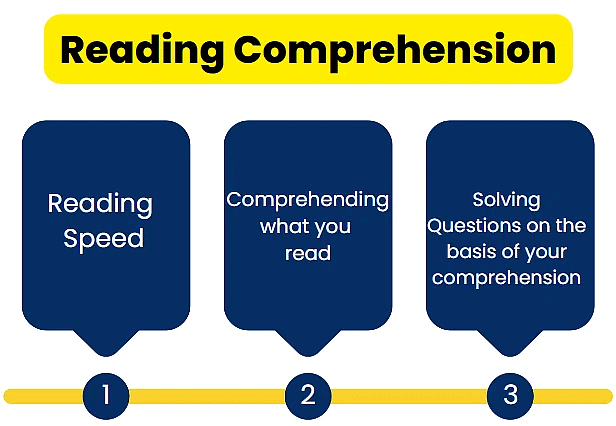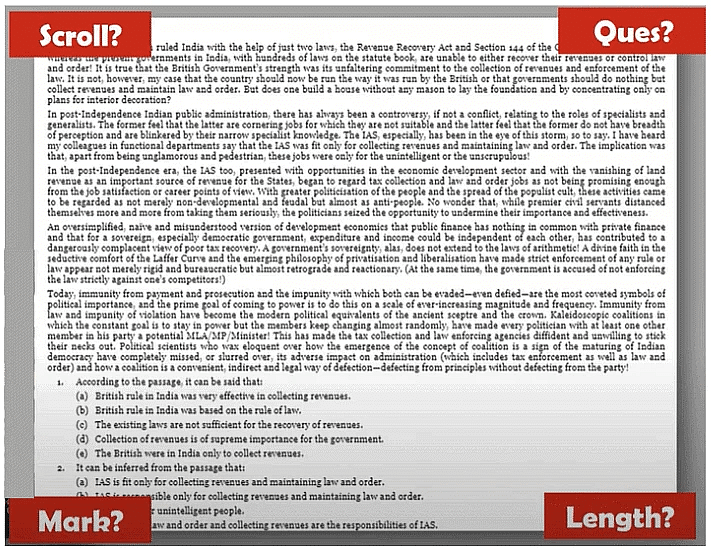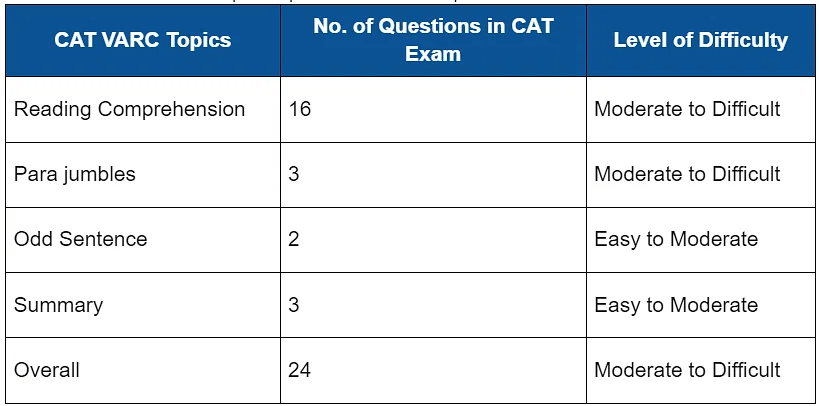Challenges faced in Reading Comprehension (RC) | Tips to solve RC in VARC | How To Score 99+ Percentile in CAT (Tips by Toppers) PDF Download
A common problems that EduRev experts have noticed in CAT aspirants is that they say "I'm not good at reading long paragraphs" or "I don't have a habit of reading" or "How long does it take to build reading habit?"
Don't worry, even if you do not have a reading habit, it will only take you merely 3-6 months to develop a good enough VARC skill set.
CAT VARC 2023: Introduction to Reading Comprehension
The Common Admission Test (CAT) consists of 3 sections, Quantitative Aptitude (QA), Data Interpretation and Logical Reasoning (DILR) and Verbal Ability and Reading Comprehension (VARC).
- The Reading Comprehension is an important component of the CAT VARC exam, and it makes up 67% of the total section.

- This section includes passages ranging in length from one paragraph to several pages long.
- The passages in the CAT VARC Reading Comprehension section can be based on a variety of topics, including business, economics, psychology, history, and more.
- The passages are written in an academic style and can include difficult words and complex sentence structures.
- The questions in this section are designed to test your ability to understand the main ideas of the passage, draw conclusions, make inferences, and identify the author's tone.
- It is important to read the passages closely and pay attention to the details in order to answer the questions correctly.
Now that you know the importance of Reading Comprehension component, it is necessary that you practice these. EduRev has curated 100 RCs for Practice course with detailed explanations of each answer. You will learn to identify the important components of a reading passage and develop your ability to quickly and accurately answer RC questions.
Also Read:
Types of Reading Comprehension Questions
Challenges faced in Reading Comprehension (RC)
The most common challenges that EduRev experts have identified after guiding a lot of students of CAT are listed below:

1. Unfamiliar context in passages:
- Reading Comprehension (RC) passages covers a wide range of topics and may be written in a variety of styles.
- It is not uncommon for the passages to cover topics or use language that is unfamiliar to the aspirant.
- In such cases, it is important to try to understand the main ideas of the passage and to use context clues and the surrounding sentences to help interpret unfamiliar words or phrases.
- It is also helpful to try to relate the information in the passage to your own knowledge or experiences.
2. Difficult Vocabulary:
- The VARC section may also contain words that are not commonly used or that are technical in nature.
- It is important to try to understand the meaning of these words in the context of the passage, and to use the surrounding sentences and context clues to help interpret their meaning.
- It may also be helpful to try to break down longer words into their component parts and to look up the definitions of any words that you are not familiar with.
Also Read:
How to improve vocabulary for CAT?
3. Confusing or very close ideas in options:
- The questions in the VARC section may present options that are very similar or that use similar language, making it difficult to determine the correct answer.
- In such cases, it is important to carefully read the entire question and all of the options, paying attention to the specific language used and the context in which the options are presented.
- It may also be helpful to reread the relevant parts of the passage to gain a deeper understanding of the content and to better differentiate between the options.
4. No interest in reading:
- It is natural for some individuals to be more interested in some topics than others.
- However, in the VARC section of the CAT, it is important to approach all passages with an open mind and a willingness to learn, even if the topic is not initially appealing.
- Taking the time to understand the main ideas and arguments presented in the passage can help improve your overall performance on the VARC section.
5. Slow reading speed:
- Reading speed is an important factor to consider when tackling the VARC section of the CAT.
- If you find that you are reading too slowly, it may be helpful to try some speed reading techniques, such as skimming the passage to get a general understanding before reading it in more detail or using a pacer to help maintain a steady reading pace.
6. Regression:
- Regression refers to the tendency to go back and reread parts of the passage or question.
- While it is important to fully understand the content of the passage and the questions, excessive regression can slow down your progress and may lead to time constraints.
- If you find yourself regressing frequently, it may be helpful to try to identify the specific cause of your regression and to address it directly.
- For example, if you are regressing due to difficulty understanding the language or content of the passage, you may benefit from using context clues and looking up unfamiliar words.
7. Extra long RCs:
- The VARC section may include Reading Comprehension passages that are longer than those you are used to encountering.
- These longer passages can be more time-consuming and may require more effort to understand and process the information.
- To manage your time effectively when tackling extra long RCs, it may be helpful to skim the passage to get a general understanding of the content before reading it in more detail, to focus on the main ideas and arguments presented, and to take brief breaks to rest your eyes and clear your mind.
8. Not achieving accuracy even after practicing a lot:
It is common for individuals to experience some level of difficulty when preparing for the VARC section of the CAT, and it is normal
You must be aware that the Reading Comprehension section can be one of the most challenging parts of the exam.
It requires a lot of hard work and dedication to master the art of understanding complex passages and answering the associated questions correctly.
What better way to start by getting to know the reading culture followed in IIMs.
9. Lack of time:
- The time allotted for this section is limited, so it can be difficult to finish all the questions within the time frame.
- This can lead to making rushed decisions and getting the wrong answers.
10. Lack of resources:
- It can be difficult to find resources that can help you prepare adequately for this section of the exam.
- It is important to identify the right resources and use them to your advantage.
CAT VARC 2023: Understanding Reading Comprehension Elements
Reading comprehension usually consists of 3 elements
- Reading Speed
- Comprehension
- Solving

1. Reading Speed
Reading speed is an important factor for success in the Common Admission Test (CAT) exam. The ability to quickly read and understand text is essential for solving questions within the time limits of the exam. For increasing reading speed you can refer to EduRev article on how to read for reading comprehension.
Keep the following points while taking into consideration the reading speed:
a. Never use offline material:
- There is a lot difference between attempting an offline and online reading comprehension.
- In online reading comprehension you have to scroll through the paragraph, you have to refer back to the the paragraph after going through the questions.

- You can not mark or underline in the CAT Online exam as well.
b. Read Editorials:
- In the online format, you can use the editorials which will help you assess the level of difficulty. You can refer to The Hindu Newspaper for vocabulary and editorials.
- Try reading at least 1 editorial daily if not all of them.
c. Broaden your Vocabulary
- You need to work on your vocabulary skills
- This will enable a student to understand the questions and respond appropriately.
- Additionally, CAT tests are designed to measure the student's ability to think critically and use language effectively.
- You need to figure out the meaning and context of the word while attempting an RC because sometimes trigger words are the only reason
- Finally, having a strong vocabulary will enable a student to be able to read and understand complex texts, which is essential for success in college and beyond.
Also Read:
How to improve vocabulary for CAT?
Types of Reading Comprehension Questions
2. Comprehending what you read
Technique 1: Passage by Point
- Every comprehension passage is divided into paragraphs and it is authors rule that each paragraph represents a different point.

- Convert each paragraph into one liners
- Try this technique with a few RCs and you will be able to identify the difference in your scores.
Technique 2: Skimming Test
How are reading and skimming different?
- Skimming is basically reading rapidly so that you are able to get an overview of the material that you are reading.
- You need to know this difference and learn the art of both skimming and reading.

- Usually, when you read and RC which is very long, you can read the introductory parts of the passage, that is introducing to a new idea or a concept; and then skim through the parts that are an extension of it.
- This will mean that when you get a question based on that particular idea, you will know where it is located in the passage (because you read it thoroughly), you can now visit that para quickly and read the parts you skimmed through.
- This was you save a lot of time, and you are way more accurate in answering the questions!
Technique 3: Moving On
- Don’t get stuck on difficult words that appear in the passage. A lot of students get lost in the web of complex words that the RC shoots at you.
- Don’t let it perturb your attention. Keep continuing ahead and focus more on the idea being conveyed rather than specific words.
- Unless the question asks for the meaning of a specific word, you need not pay much attention to it.
- The gist of the passage will be conveyed to you even if you don’t understand a few words, so don’t waste time on it.
Technique 4: No facts or figures

- You do not need to memorize facts or figures in reading comprehension.
- Reading comprehension involves understanding the main ideas and arguments presented in a text and making connections between the text and the reader's own experience and knowledge.
- Memorization of facts or figures is not necessary to understand the text.
Technique 5: Vocabulary
- The more familiar you are with different words, the faster you will be able to read the matter.
- Increasing your vocabulary by learning new words and reading more often will naturally increase your reading speed.
- When you read a sentence with 2 or more words that are new to you, you tend to read it twice or thrice.
- Now imagine you do this for the entire passage! Your time gets wasted unnecessarily on things like this.
- This is why, reading regularly is required, as you will learn new words and its usage, and hence will be able to comprehend the passage faster and with much ease.
Technique 6: Focus on Transition Words
- Transition words in reading comprehension can be used to help students make connections between ideas and better understand the material.
- Transition words can help you remember important points and create a logical flow of information.
- They can also help you make inferences about the text or draw conclusions about the author’s purpose.

- Transition words can also be used to signal a change of direction or introduce a new idea.
- Examples of transition words include words such as “however,” “therefore,” “on the other hand,” and “in conclusion.”
3. Solving Passages on the basis of your understanding
Once the passage is understood, it is important to practice and develop the skills needed to answer the questions. This includes developing strategies for quickly identifying the main points in the passage and understanding the tone and structure of the passage.
Important Strategies to Solve Comprehension Passages
Fortunately, there are several strategies that can help you overcome these challenges. Here are some tips to help you prepare for the CAT VARC Reading Comprehension section
1. Read the passage thoroughly
- It is important to read the passages in this section carefully take note of any words that may be unfamiliar.
- When reading the passage, it is important to make connections between ideas in the text.
- Additionally, it is helpful to think about the context in which the passage was written and how it relates to the broader topic that is being discussed.
- Understand the main idea of the passage. Once you have read the passage, it is important to identify the main idea of the passage.
2. Understand the Questions
- Once you have identified the main idea of the passage, it is important to understand the questions and what they are asking you.
- Once you are sure of what the question is asking, it is then possible to look for keywords in the passage to help you answer the question correctly.
- Additionally, you can narrow down the search by re-reading the section of the passage that is most relevant to the question.
- Taking the time to understand the questions and what they are asking can help ensure you answer them correctly and boost your chances of success.
3. Identify Important Words and Phrases
- Identifying important words and phrases in a passage is a key strategy for answering questions correctly.
- By selecting the most relevant words and phrases, you can focus your attention on the main ideas of the passage. This will help you better understand the context and identify key points that will aid in answering the questions.
- Additionally, recognizing key words and phrases can help you eliminate incorrect answers, as they are often used to distract and confuse the reader.
- Therefore, recognizing and focusing on the important words and phrases can help you answer questions accurately and confidently.
4. Make Inferences and Draw Conclusions
- Reading between the lines and making inferences and drawing conclusions can help you answer the questions correctly.
- In order to make inferences and draw conclusions, readers must have a thorough understanding of the text, as well as the ability to connect the ideas and images within the text to their own experiences and knowledge.
- Additionally, readers must be able to look at the text critically and analyze the author's purpose and perspective.
- Once readers have a solid understanding of the text, they can look for patterns and clues that can help them make logical inferences and draw conclusions.
5. Identify the Author's Tone
- It is important to identify the author's tone and determine how it affects the meaning of the passage.
- The author's tone in the passage likely conveys a sense of urgency and importance.
- The author is stressing the importance of identifying the author's tone in order to gain a better understanding of the message being conveyed.
- The tone may also be conveying a sense of authority and confidence, as the author is providing advice and guidance on a specific subject.
6. Read the Questions First
- It is important to read all the questions before you begin reading the passage.
- This will help you focus on the main ideas of the passage and identify the answers more quickly.
7. Use the Process of Elimination
- If you are stuck on a question, you can use the process of elimination to eliminate the wrong answers and narrow down your choices.
- The process of elimination is a problem-solving technique used to narrow down potential solutions or answers to a problem.
- It involves eliminating wrong answers or potential solutions until only the correct answer remains.
- For example, if you are stuck on a multiple-choice question, you can use the process of elimination to eliminate the wrong answers and narrow down your choices.
- This can help you save time and make it easier to find the correct answer.
While solving Reading Comprehensions (RCs) you might face multiple challenges. EduRev experts have identified the most common challenges faced by aspirants.
Also Read:
Best Books for CAT Preparation
How to improve vocabulary for CAT?
Types of Reading Comprehension Questions
Frequently Asked Questions(FAQs) on Challenges in Reading Comprehension
What is the weightage of reading comprehension in the CAT VARC section?
- VARC (Verbal Ability and Reading Comprehension) is one of the three sections in the Common Admission Test (CAT).
- VARC has the maximum weightage in CAT and it is also the first section of the CAT question paper that candidates have to solve within 40 minutes.
- Within the VARC section of CAT, reading comprehension has maximum weightage.
- So, candidates need to focus on RCs during the preparation.
- Reading comprehension makes up the majority of this portion. This part typically has 4 to 5 passages every year, each of which has 3 to 6 questions.
- The remaining questions assess the candidates' verbal ability and might be on a variety of subjects. The list below contains the anticipated topic-wise distribution of questions.

How can I improve my reading comprehension?
Step 1: Read the passage
Read the passage, ensuring that you have understood 70% of it; if you have not understood it, don’t panic, read the whole passage again. On an average, we all—that includes me—need at least two readings to comprehend a well-written passage.
Step 2: Read the first question of the RC
Questions are of two types: the first whose answers are directly stated in the passage, and the second whose answers are not directly stated, but are suggested, implied or are to be inferred from the passage.
Step 3: After reading the passage, go to that part of the passage from where the question has come
Step 4: Use elimination technique for tough questions
If you zero down on two options but are not able to pick the right choice; go to the passage, look for the evidence, what has the passage to say, where is the author’s stand, where is the evidence… so on and so forth. It is these careful deliberations that will help you arrive at the right answer.
Step 5: CAT RC more than anything need deep and thorough analysis
Learn and analyze as much as possible; you must take home some lessons from every RC and every mock. If you have stopped learning, then you have either become perfect, something that is highly unlikely or are not practicing from the right kind of material.
If you think you are suffering from RC phobia, then this is the right thing for you:
100 RCs for Practice. It has explanatory answers for all the questions and it also provides you with overall analysis of all the RC passage you attempt
What tips can I follow to ace VARC CAT?
- Read the question thoroughly and identify the question type: To ace VARC, you need to be able to identify and solve questions of various types. Look out for keywords in the questions such as compare, contrast, inference, etc. and figure out what the question is asking.
- Develop an approach: It is important to develop a strategy for attempting the questions. Try to eliminate the wrong options first and then narrow down to the one that is most likely to be the correct answer.
- Time management: Time management is key to success in VARC. Make sure you plan your approach to the questions and do not spend too much time on any single question.
Check out the 120 Day plan for VARC offered by EduRev to help you ace the exam - Practice: The more you practice, the better you will get at solving the questions. Make use of the various resources available online such as EduRev for CAT to find practice material and test your skills.
What are the topics that I need to focus on for VARC CAT?
The Verbal Ability and Reading Comprehension (VARC) section of CAT is one of the most important sections of the exam. It tests your ability to comprehend passages and answer questions based on them.
To prepare for VARC, it is essential to focus on the following topics:
- Reading Comprehension: You should practice various types of passages from different areas to understand the various types of questions that are asked.
- Vocabulary: Learn new words and understand the context in which they are used.
- Grammar: Focus on grammar basics such as tenses, subject-verb agreement, parts of speech, etc.
- English Usage: This includes questions related to English usage such as synonyms, antonyms, idioms, and phrases.
For detailed information on VARC, you can also check out the VARC preparation material available at EduRev. It includes solved questions, practice tests, and tips to help you ace the VARC section of CAT.
How many types of questions are there in Reading Comprehension in CAT VARC?
- Reading comprehension makes up the majority of this portion. This part typically has 4 to 5 passages every year, each of which has 3 to 6 questions.
- The remaining questions assess the candidates' verbal ability and might be on a variety of subjects. The list below contains the anticipated topic-wise distribution of questions.

|
7 videos|19 docs
|
FAQs on Challenges faced in Reading Comprehension (RC) - Tips to solve RC in VARC - How To Score 99+ Percentile in CAT (Tips by Toppers)
| 1. What are the common challenges faced in Reading Comprehension (RC)? |  |
| 2. How can one improve their Reading Comprehension skills? |  |
| 3. What are some effective strategies to solve Comprehension Passages? |  |
| 4. How can one improve their vocabulary for better Reading Comprehension? |  |
| 5. How can time management be improved while solving Reading Comprehension passages in the CAT exam? |  |





















